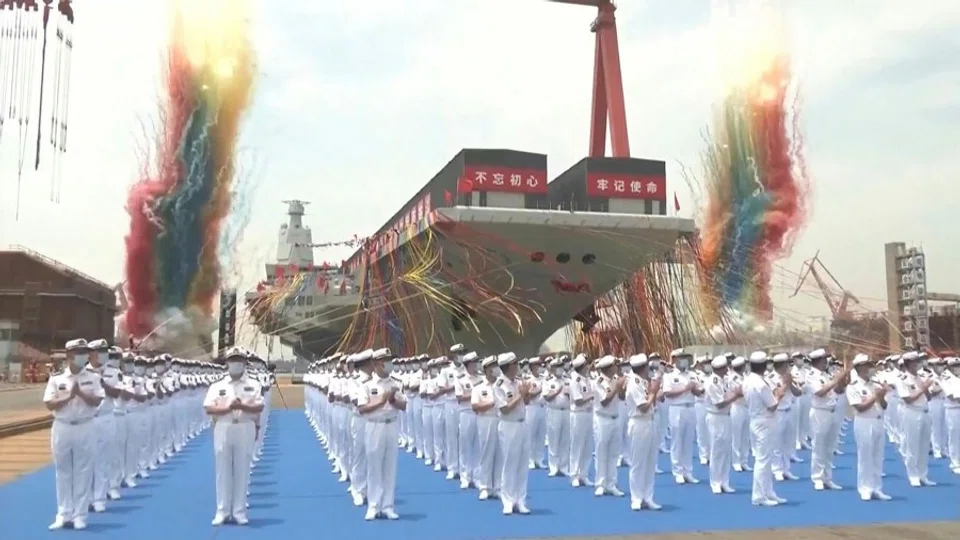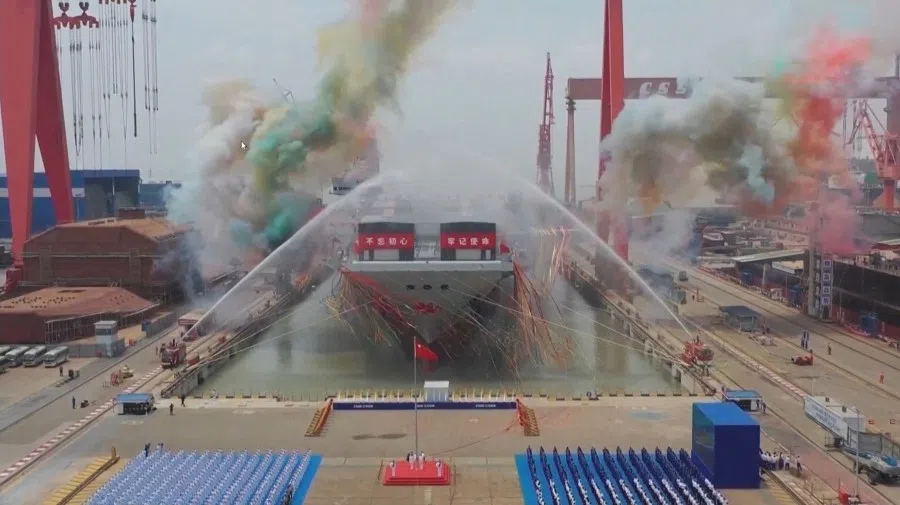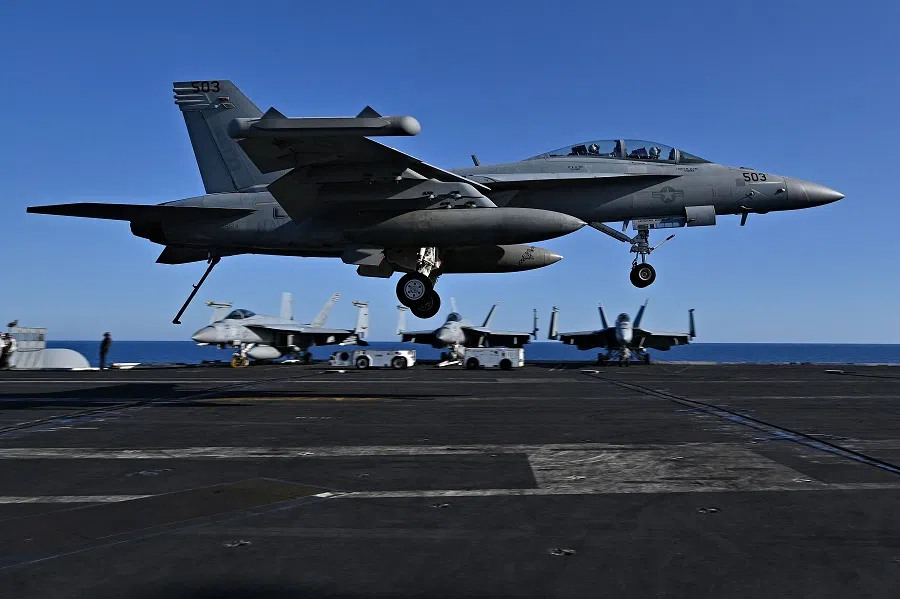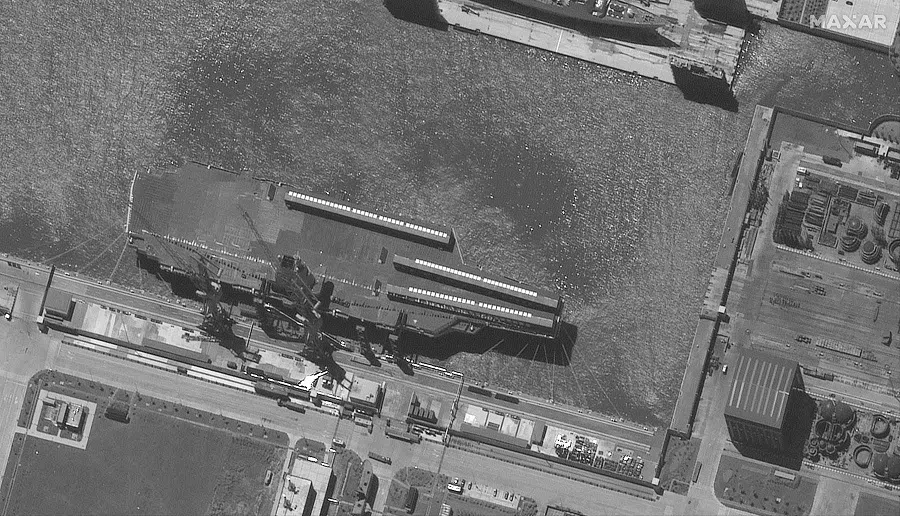With the Fujian, is China catching up to the US in aircraft carrier manufacturing technology?
The Fujian, China's third aircraft carrier, was launched on 17 June. The highlight is the electromagnetic catapult system for launching aircraft, which could put it on par with much of the US's cutting-edge technology in the field. Zaobao correspondent Yu Zeyuan takes a closer look at the implications of this development.

China's third aircraft carrier named "Fujian" was unveiled on 17 June to much fanfare. For China's military fans who cheered the launch, this signals that China's aircraft carrier manufacturing technology is second in the world, and the country is starting to match the US as the number one in aircraft carriers.
The previous two aircraft carriers - the Liaoning and Shandong - addressed China's earlier military needs, and played a role in developing the country's aircraft carrier manufacturing technology and training and combat management capabilities. However, the Liaoning and Shandong cannot match the Nimitz and Ford class carriers of the US in terms of tonnage, propulsion and launching efficiency.
But the Fujian is very different... it has leapfrogged the steam catapult system of the Nimitz class straight to the electromagnetic catapult system of the Ford class.
But the Fujian is very different. Not only does it have a significantly larger tonnage than the previous two carriers, with a full load displacement of at least 80,000 tonnes, it has leapfrogged the steam catapult system of the Nimitz class straight to the electromagnetic catapult system of the Ford class.

Tonnage is the basis of the number of aircraft carried. The Liaoning and Shandong have normal load displacements of about 50,000 tonnes and full load displacements of over 60,000 tonnes; the Fujian has a full load displacement of over 80,000 tonnes and a flat-top flight deck, which means its aircraft capacity might be at least 60, an increase from the 30 aircraft of the Liaoning and Shandong.
But the highlight of the Fujian is not so much its tonnage, but the use of an electromagnetic catapult system for launching aircraft, a mark of advanced technology on new-generation aircraft carriers. Of the 11 US aircraft carriers in service, only the new Gerald R. Ford uses an electromagnetic launch system, with the other ten Nimitz class vessels using a steam launch system.
An electromagnetic launch system allows aircraft to quickly reach or approach flight speed within a short distance. The high-pressure long stroke piston that is the core of the steam launch system is costly and more intricate to produce than the electromagnetic system, and requires a lot of pure water on board. Also, the steam launch system is not as efficient as the electromagnetic system, and experiences more faults.

The advantages of the electromagnetic launch system over the steam system are clear, such as digital management and monitoring, adjustable launch strength to suit different aircraft, as well as being lighter and more compact and easier to maintain.
At the same time, electromagnetic launch systems do not lose power with a growing number of sorties, which reduces stress and strain on aircraft and pilots alike during launches. US naval tests show that the four steam catapults on the Nimitz class vessels allow up to 200 launches a day, while the four electromagnetic launchers on the Gerald R. Ford allow up to 270.
Leapfrogging and maybe surpassing
While the US considers aircraft carriers with electromagnetic catapult systems to be new-generation aircraft carriers, the Gerald R. Ford's medium-voltage direct current (MVDC) integrated power system is still imperfect. In theory, it fails only once every 4,100 times, but in practice, it fails approximately once every 400 times. Due to the high failure rate, the Gerald R. Ford has yet to be deployed despite being in service for several years.
The technical prowess of the Fujian is expected to surpass that of the Gerald R. Ford. With an integrated power system developed by leading Chinese naval engineer Ma Weiming, the Fujian's MVDC integrated power system is capable of the more stable direct DC output. Not only are complex transformer/rectifier systems no longer needed, its energy conversion efficiency rate should theoretically reach over 90%, raising its efficiency to 60% over that of the Gerald R. Ford's MVDC system.
Mooring tests and sea trials take about two years. That is to say, the Fujian may go into service in 2024, and be battle-ready only after 2025.

Online news reports claim that the Fujian's electromagnetic catapults have been tested tens of thousands of times on land with an extremely low failure rate. If the results of these pilot tests can be sustained and the Fujian can launch anything from large airborne early warning (AEW) aircraft to small drones, its overall combat capabilities will far exceed that of the Liaoning and Shandong.
Based on a video of the launch ceremony of the Fujian released by Chinese state media, the aircraft carrier's three catapults are still kept under wraps in environmental shelters. State media reports said that the aircraft carrier is set to undergo mooring tests and sea trials next, which means the outfitting work will be done soon.
Mooring tests and sea trials take about two years. That is to say, the Fujian may go into service in 2024, and be battle-ready only after 2025.
China has to overcome the nuclear power hurdle if it wants to catch up with and overtake the US in terms of aircraft carrier technology.

With the Fujian, China has raised its aircraft carrier manufacturing technology to a whole new level, but one must not forget that the aircraft carrier still runs on conventional power and lags far behind the US's 11 nuclear-powered aircraft carriers. China has to overcome the nuclear power hurdle if it wants to catch up with and overtake the US in terms of aircraft carrier technology.
However, it is a challenge to advance the development of nuclear reactors for nuclear-powered aircraft carriers. Currently, only the US has truly developed nuclear reactors for aircraft carriers - France's aircraft carrier nuclear reactor technology is derived from its nuclear-powered attack submarine. At present, China does not have nuclear-propelled surface vessels, and it could take a few more years to solve the aircraft carrier nuclear reactor problem. That is to say, China's fifth aircraft carrier could be nuclear powered.


![[Big read] Paying for pleasure: Chinese women indulge in handsome male hosts](https://cassette.sphdigital.com.sg/image/thinkchina/c2cf352c4d2ed7e9531e3525a2bd965a52dc4e85ccc026bc16515baab02389ab)

![[Big read] Love is hard to find for millions of rural Chinese men](https://cassette.sphdigital.com.sg/image/thinkchina/16fb62fbcf055b710e38d7679f82264ad682ce8b45542008afeb14d369a94399)
